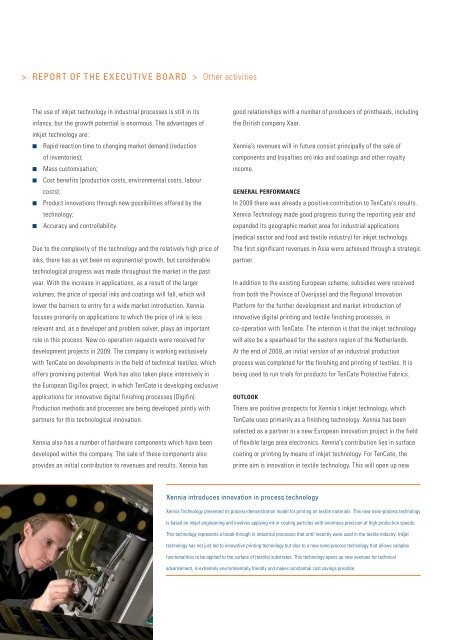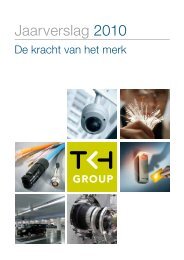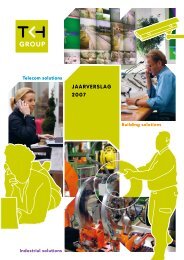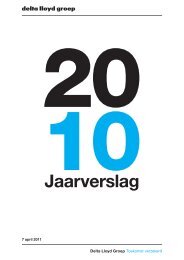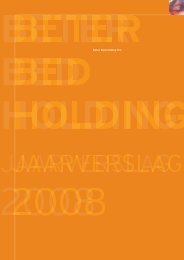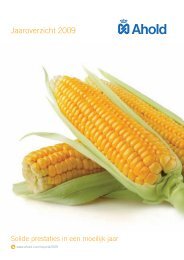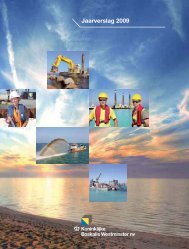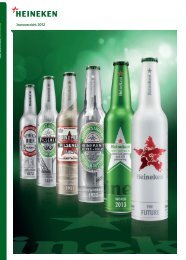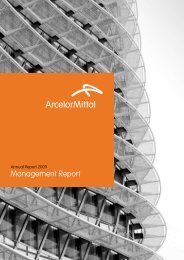2009 - Jaarverslag
2009 - Jaarverslag
2009 - Jaarverslag
Create successful ePaper yourself
Turn your PDF publications into a flip-book with our unique Google optimized e-Paper software.
REPORT OF THE EXECUTIVE BOARD > Other activitiesThe use of inkjet technology in industrial processes is still in itsinfancy, but the growth potential is enormous. The advantages ofinkjet technology are:◾ Rapid reaction time to changing market demand (reductionof inventories);◾ Mass customisation;◾ Cost benefits (production costs, environmental costs, labourcosts);◾ Product innovations through new possibilities offered by thetechnology;◾ Accuracy and controllability.Due to the complexity of the technology and the relatively high price ofinks, there has as yet been no exponential growth, but considerabletechnological progress was made throughout the market in the pastyear. With the increase in applications, as a result of the largervolumes, the price of special inks and coatings will fall, which willlower the barriers to entry for a wide market introduction. Xenniafocuses primarily on applications to which the price of ink is lessrelevant and, as a developer and problem solver, plays an importantrole in this process. New co-operation requests were received fordevelopment projects in <strong>2009</strong>. The company is working exclusivelywith TenCate on developments in the field of technical textiles, whichoffers promising potential. Work has also taken place intensively inthe European DigiTex project, in which TenCate is developing exclusiveapplications for innovative digital finishing processes (Digifin).Production methods and processes are being developed jointly withpartners for this technological innovation.Xennia also has a number of hardware components which have beendeveloped within the company. The sale of these components alsoprovides an initial contribution to revenues and results. Xennia hasgood relationships with a number of producers of printheads, includingthe British company Xaar.Xennia’s revenues will in future consist principally of the sale ofcomponents and (royalties on) inks and coatings and other royaltyincome.GENERAL PERFORMANCEIn <strong>2009</strong> there was already a positive contribution to TenCate’s results.Xennia Technology made good progress during the reporting year andexpanded its geographic market area for industrial applications(medical sector and food and textile industry) for inkjet technology.The first significant revenues in Asia were achieved through a strategicpartner.In addition to the existing European scheme, subsidies were receivedfrom both the Province of Overijssel and the Regional InnovationPlatform for the further development and market introduction ofinnovative digital printing and textile finishing processes, inco-operation with TenCate. The intention is that the inkjet technologywill also be a spearhead for the eastern region of the Netherlands.At the end of <strong>2009</strong>, an initial version of an industrial productionprocess was completed for the finishing and printing of textiles. It isbeing used to run trials for products for TenCate Protective Fabrics.OUTLOOKThere are positive prospects for Xennia’s inkjet technology, whichTenCate uses primarily as a finishing technology. Xennia has beenselected as a partner in a new European innovation project in the fieldof flexible large area electronics. Xennia’s contribution lies in surfacecoating or printing by means of inkjet technology. For TenCate, theprime aim is innovation in textile technology. This will open up newXennia introduces innovation in process technologyXennia Technology presented its process-demonstration model for printing on textile materials. This new nano-process technologyis based on inkjet engineering and involves applying ink or coating particles with enormous precision at high production speeds.This technology represents a break-through in industrial processes that until recently were used in the textile industry. Inkjettechnology has not just led to innovative printing technology but also to a new nano-process technology that allows complexfunctionalities to be applied to the surface of (textile) substrates. This technology opens up new avenues for technicaladvancement, is extremely environmentally friendly and makes substantial cost savings possible.52Royal Ten Cate


